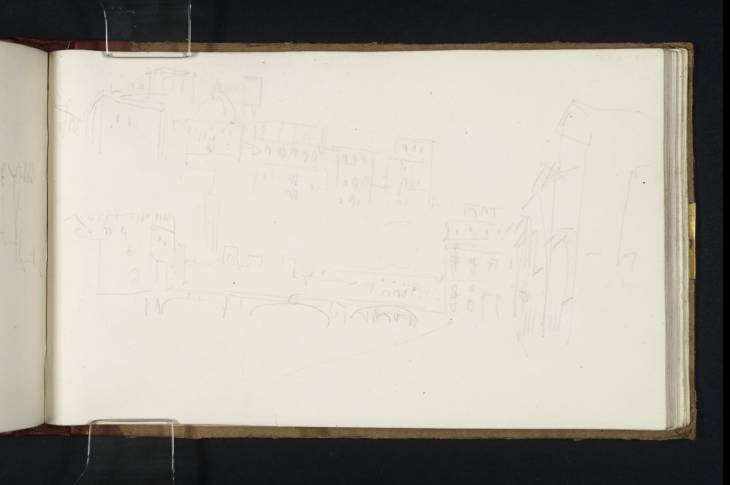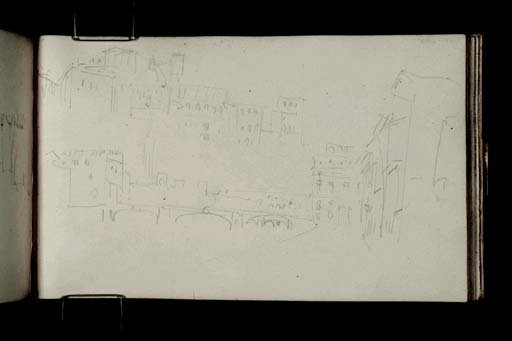Joseph Mallord William Turner Ponte Santa Trinita and Ponte Vecchio from the Lungarno Guicciardini, Florence 1819
Image 1 of 2
Joseph Mallord William Turner,
Ponte Santa Trinita and Ponte Vecchio from the Lungarno Guicciardini, Florence
1819
Joseph Mallord William Turner 1775–1851
Folio 40 Verso:
Ponte Santa Trinita and Ponte Vecchio from the Lungarno Guicciardini, Florence 1819
D16558
Turner Bequest CXCI 40 a
Turner Bequest CXCI 40 a
Pencil on white wove paper, 113 x 189 mm
Accepted by the nation as part of the Turner Bequest 1856
References
1909
A.J. Finberg, A Complete Inventory of the Drawings of the Turner Bequest, London 1909, vol.I, p.568, as ‘Ponte di Santa Trinita’.
1984
Cecilia Powell, ‘Turner on Classic Ground: His Visits to Central and Southern Italy and Related Paintings and Drawings’, unpublished Ph.D thesis, Courtauld Institute of Art, University of London 1984, pp.205 note 27, 209 note 42, 430, as ‘Ponte S. Trinita and Ponte Vecchio from the Lungarno Guicciardini (cf. Turner’s earlier watercolour, W, no.713).
1987
Cecilia Powell, Turner in the South: Rome, Naples, Florence, New Haven and London 1987, p.95 note 29.
The view depicted by Turner in this sketch is one of the standard scenes of the Florentine vedute tradition, looking upstream (east) from the Lungarno Guicciardini on the left (southern) bank of the River Arno. Spanning the river in the foreground is the three-arched Ponte Santa Trinita, whilst visible beyond is the medieval bridge, the Ponte Vecchio. At the right-hand end of the Ponte Santa Trinita is the Palazzo della Missione, formerly the palace of the Frescobaldi family, whilst at the left-hand end is the Palazzo Spini Ferroni, the grandest medieval residence in the city. Rising above the buildings lining the northern bank is the tower of the Palazzo Vecchio and the artist has continued to record the topography to the left of the Ponte Santa Trinita in the top left-hand corner of the page. A similar view with nearby Ponte Carraia can be seen on folio 73 verso (D16607).
The sketch repeats the same view depicted by Turner in an earlier watercolour, Florence from the Ponte alle Carraia circa 1816–17 (Whitworth Art Gallery, Manchester),1 which was itself based upon a drawing by James Hakewill (1778–1843), Ponte della Trinità on the Lung’Arno – Florence 1816 (British School at Rome Library), and published in Hakewill’s Picturesque Tour of Italy, 1820.2 The viewpoint for Hakewill’s prospect was the Pensione Schneider, a Florentine hotel on the Lungarno Guicciardini widely favoured by British tourists. Hakewill recommended this establishment to Turner within his notes in the Route to Rome sketchbook (Tate D13878; Turner Bequest CLXXI 11). Although it is not known whether the artist in fact stayed there, he would certainly have been aware of its popularity, and the famous river vista to be seen from the nearby embankment. A similar view was depicted by the eighteenth-century vedute artist Giuseppe Zocchi (1711–1767), as well as a number of other foreign painters.3
Nicola Moorby
December 2010
See Tony Cubberley and Luke Herrmann, Twilight of the Grand Tour: A Catalogue of the Drawings by James Hakewill in the British School at Rome Library, Rome 1992, no.2.36, p.153, reproduced.
See Veduta di una parte di Lung Arno, e del Ponte a S. Trinita presa dal Palazzo del Sigr: March: Ruberto Capponi, reproduced in Vues de Florence et de Toscane d’après Giuseppe Zocchi, exhibition catalogue, Cabinet des Estampes Musée d’Art et d’Historique Genève 1974, as pl.9, Le Ponte Santa Trinita; see also Powell 1987, p.95.
How to cite
Nicola Moorby, ‘Ponte Santa Trinita and Ponte Vecchio from the Lungarno Guicciardini, Florence 1819 by Joseph Mallord William Turner’, catalogue entry, December 2010, in David Blayney Brown (ed.), J.M.W. Turner: Sketchbooks, Drawings and Watercolours, Tate Research Publication, December 2012, https://www


